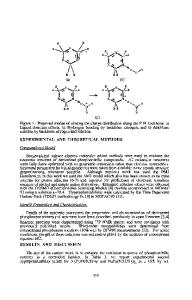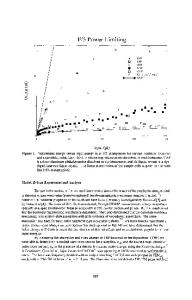Nonlinear Optical Properties of Silicon Nanocrystallites: Effects of Passivation
- PDF / 457,985 Bytes
- 6 Pages / 414.72 x 648 pts Page_size
- 69 Downloads / 344 Views
ABSTRACT Degenerate four-wave mixingwith picosecond pulses at 532 nm has been used to study the third-order nonlinear optical susceptibility (x(3) for a series of passivated thin films of silicon nanocrystallites. A pulsed laser ablation supersonic expansion source of isolated silicon nanocrystallites was used to deposit thin films onto inert substrates. These films were subsequently passivated using chemical etches or oxidation steps. We observe a strong dependence of the measured X(3) as a function of the degree of passivation, indicating the fundamental importance of the surface of the nanocrystallite in enabling the nonlinear optical behavior. Systems providing more complete passivation were found to have greatly enhanced X(3) behavior when compared to poorly passivated systems. Surface passivation is also shown to be critical to the visible photoluminescence behavior of the thin films, as poorly passivated nanocrystallites exhibit very weak light emission, while well passivated systems show efficient emission. In both cases, the passivation controls the recombination pathways of excited carriers and determines the material's optical properties. INTRODUCTION
The nonlinear optical properties of nanocrystallites have received a great deal of attention recently, especially in compound semiconductor systems.' The expected enhanced nonlinear response of these systems over bulk semiconductors has been observed in a number of materials. These properties can be exploited for use in optoelectronic devices and other applications. Research in nanostructured silicon has centered on the visible light emitting properties of nanocrystalline and porous silicon.2,3 Though potential applications of silicon visible light emitters are of considerable interest, another major advantage of this system is its ability to be relatively easily integrated into existing Si-based electronics technology. For example, the production of Si based optoelectronic switches would provide for considerable advantages over other materials systems, when one takes into account the vast database of knowledge that already exists in silicon synthesis and processing techniques. Useful photonic devices will require that the systems being used show strong optical nonlinearities, since they will be based on the interaction of light beams with an active material. To this end, we have examined the nonlinear optical properties of visible light emitting silicon nanocrystallites. In particular, we have studied the X() response of our silicon nanocrystallites. To date, all-optical switches have been developed in systems whose nonlinearity results from the thirdorder nonlinear optical susceptibility. In these systems, though the materials are usually transparent, one can induce a change in their refractive index as a function of the intensity of the 205 Mat. Res. Soc. Symp. Proc. Vol. 358 01995 Materials Research Society
incident light. In most ultrafast switching devices, this is a nonresonant X() interaction and is very weak. Therefore, inorder to avoid excessiv
Data Loading...






